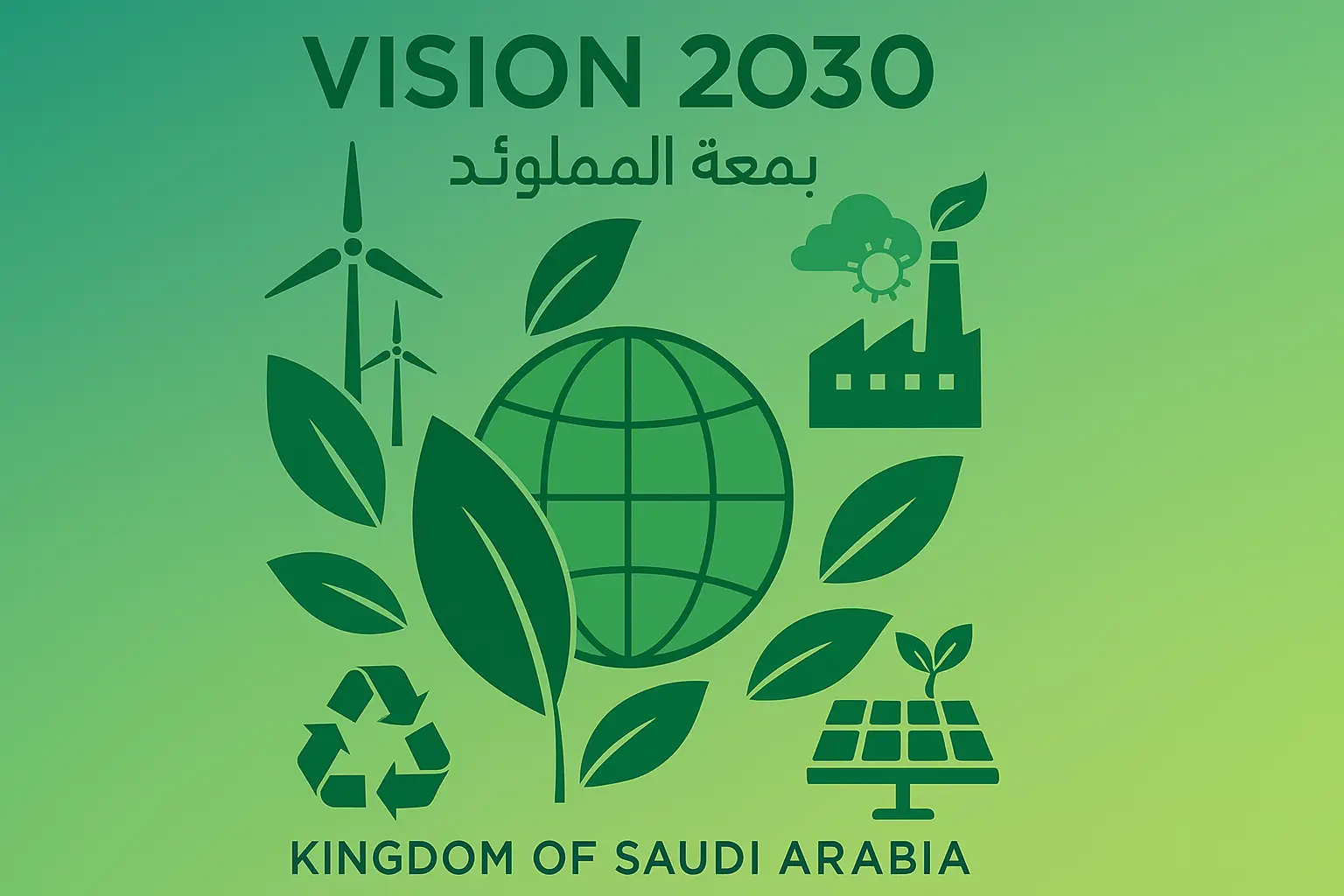AI for a Sustainable Future: Saudi Arabia’s Green Vision
Introduction: A Kingdom at the Crossroads of Innovation and Ecology
In the age of climate urgency, the phrase AI for a sustainable future has evolved from buzzword to blueprint. For Saudi Arabia, this is not just rhetoric—it’s a national imperative. Long known for its oil-rich deserts and sprawling infrastructure, the Kingdom is now pivoting toward a greener, more intelligent future. Under Vision 2030, it is harnessing Artificial Intelligence to combat environmental degradation, conserve resources, and build a new economic identity.
From predictive climate modeling to intelligent water systems and solar-powered smart cities, Saudi Arabia is showing how AI for a sustainable future can be tailored to meet the ecological challenges of even the harshest environments.
Vision 2030: The Foundation for AI-Driven Sustainability
Vision 2030 is Saudi Arabia’s bold roadmap for transformation. Environmental stewardship sits at its core. And Artificial Intelligence deployed strategically is what enables the Kingdom to bring sustainability goals into measurable action.
Vision 2030 outlines key national priorities: reduce dependence on fossil fuels, increase renewable energy use, preserve natural habitats, and modernize infrastructure. Achieving these goals requires data-driven decision-making at every level, and that’s where AI becomes indispensable.
Saudi Arabia has created organizations like the Saudi Data and Artificial Intelligence Authority (SDAIA) to guide this transition, ensuring that AI for a sustainable future isn’t just a vision but an operational reality.
Where AI Meets the Environment in Saudi Arabia
1. Smart Energy Grids and Green Power Management
Saudi Arabia is at the forefront of the green energy movement, using AI to maximize efficiency in its growing renewable energy network.
- NEOM: This futuristic smart city integrates AI into every aspect of infrastructure. AI systems manage energy generated from wind, solar, and hydrogen, forecasting demand and minimizing waste.
- Aramco’s Emission Monitoring: Saudi Aramco is implementing AI-powered sensors and digital twins to analyze emissions and improve refinery efficiency.
- Green Hydrogen: AI optimizes electrolysis operations in green hydrogen plants, adjusting for temperature, input energy, and output requirements in real-time.
These initiatives demonstrate Saudi Arabia’s commitment to integrating AI for a sustainable future at an industrial scale.
2. Intelligent Water Conservation
Water scarcity is a critical issue for Saudi Arabia. AI offers scalable solutions to conserve and manage water more effectively:
- Desalination Plants: AI helps optimize energy consumption and system operations in facilities that convert seawater to freshwater.
- Agricultural Irrigation: AI systems combine weather forecasts, crop data, and soil sensors to automate water delivery, saving vast quantities of water.
- Leak Detection: AI-enabled systems in cities like Riyadh and Jeddah detect underground leaks before they result in major losses.
By embedding AI for a sustainable future into water systems, Saudi Arabia ensures resource efficiency in every drop.
3. Clean Air and Smarter Cities
Urban environments pose unique challenges for sustainability. AI is being used to manage air quality, transportation, and urban design:
- Air Quality Sensors: Deployed across major cities, these devices use AI to predict pollution trends and trigger real-time alerts.
- Traffic Optimization: Smart transportation networks reduce emissions by improving traffic flow and minimizing idle time.
- Green Urban Planning: AI modeling helps city planners design low-emission zones, green spaces, and walkable neighborhoods.
Here, AI for a sustainable future directly impacts public health and urban livability.
4. Sustainable Agriculture and Food Security
AI helps Saudi Arabia overcome the limitations of its arid climate by enabling:
- Smart Greenhouses: Controlled environments managed by AI allow for year-round crop growth using minimal resources.
- Precision Farming: AI systems analyze satellite images, drone data, and IoT sensors to guide planting, fertilization, and harvesting.
- Disease and Pest Prediction: Early warning systems powered by AI detect threats before they cause widespread crop damage.
Through agricultural innovation, the Kingdom transforms barren lands into productive ecosystems—a key pillar of AI for a sustainable future.
5. Biodiversity and Ecosystem Protection
AI is central to conserving Saudi Arabia’s unique ecosystems:
- Wildlife Monitoring: AI processes images and video feeds to track endangered species like the Arabian leopard.
- Coral Reef Health: AI monitors changes in reef ecosystems in the Red Sea, helping scientists address bleaching events.
- Afforestation Projects: AI maps optimal planting sites and tracks tree growth under the Saudi Green Initiative.
By applying AI for a sustainable future, Saudi Arabia is building a more resilient and biodiverse natural world.
Strategic Programs and Global Collaboration
Saudi Arabia’s sustainability mission is supported by coordinated national strategies and international partnerships:
- Saudi Green Initiative (SGI): This national campaign uses AI to monitor reforestation, emissions, and clean energy milestones.
- Middle East Green Initiative: A platform for regional cooperation, sharing AI-powered environmental data and solutions.
- SDAIA + IBM Collaboration: Focused on creating AI tools for smart cities, climate forecasting, and ethical AI governance.
These programs ensure that AI for a sustainable future extends beyond Saudi borders and contributes to global goals.
The Role of Startups and Private Sector Innovation
Saudi Arabia is nurturing a new wave of green-tech entrepreneurship:
- RedSea Farms: Using AI to manage desert farming with saltwater and solar tech.
- Nomadd: Robotic cleaners for solar panels, boosting efficiency in dusty regions.
- Watad Energy: AI-driven analytics to reduce energy use in factories and logistics.
These companies are transforming Vision 2030 from a policy into practice—proof that AI for a sustainable future can be both innovative and profitable.
Education and Research
Long-term sustainability needs a skilled workforce. Saudi Arabia is investing in:
- KAUST Environmental AI Labs: Researching coral reef health, climate prediction, and marine ecosystems.
- Green AI Curricula: Universities like King Saud University now offer degrees blending AI with environmental science.
This ecosystem is laying the intellectual foundation for AI for a sustainable future to thrive.
Ethics, Data, and Responsible Innovation
To ensure responsible development, Saudi Arabia prioritizes:
- AI Ethics Guidelines: Clear rules for transparency, fairness, and sustainability.
- Data Sovereignty: Local data infrastructure ensures secure handling of sensitive environmental data.
- Inclusivity: AI solutions are designed to serve all, especially vulnerable and rural communities.
These principles ensure that AI for a sustainable future upholds human values alongside technological progress.
Challenges Ahead
Despite progress, the road is not without obstacles:
- Infrastructure Gaps: Remote regions still lack connectivity for full AI deployment.
- Talent Shortage: Demand for green AI specialists outpaces current supply.
- Legacy Systems: Older infrastructure can hinder the adoption of new AI solutions.
Yet with clear intent and ongoing investment, these challenges are surmountable.
Conclusion: A Green Legacy in the Making
Saudi Arabia’s strategic embrace of AI for a sustainable future is reshaping its economy, its environment, and its role in the world. Through smart cities, clean energy, water conservation, and ecosystem protection, the Kingdom is forging a green legacy rooted in intelligence and vision.
As the planet faces growing ecological threats, Saudi Arabia stands as an emerging leader showing how bold policy, cutting-edge AI, and ecological responsibility can work hand in hand. The desert is blooming again—this time, powered by code and purpose.
Read article
How Semantic Brains Is Driving Digital Transformation in KSA


